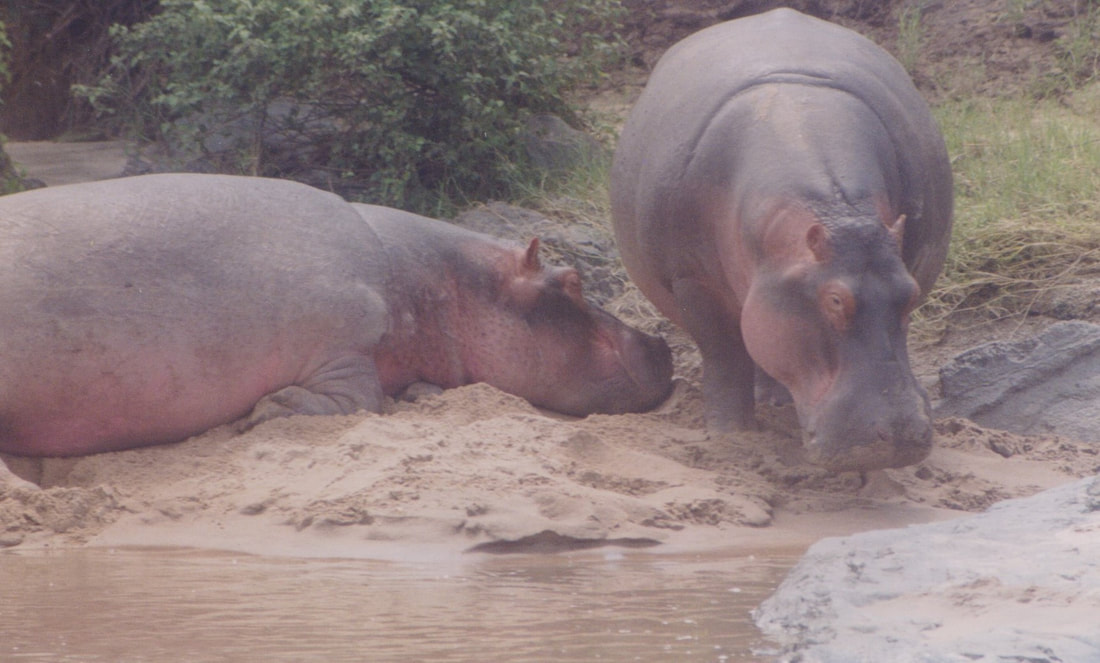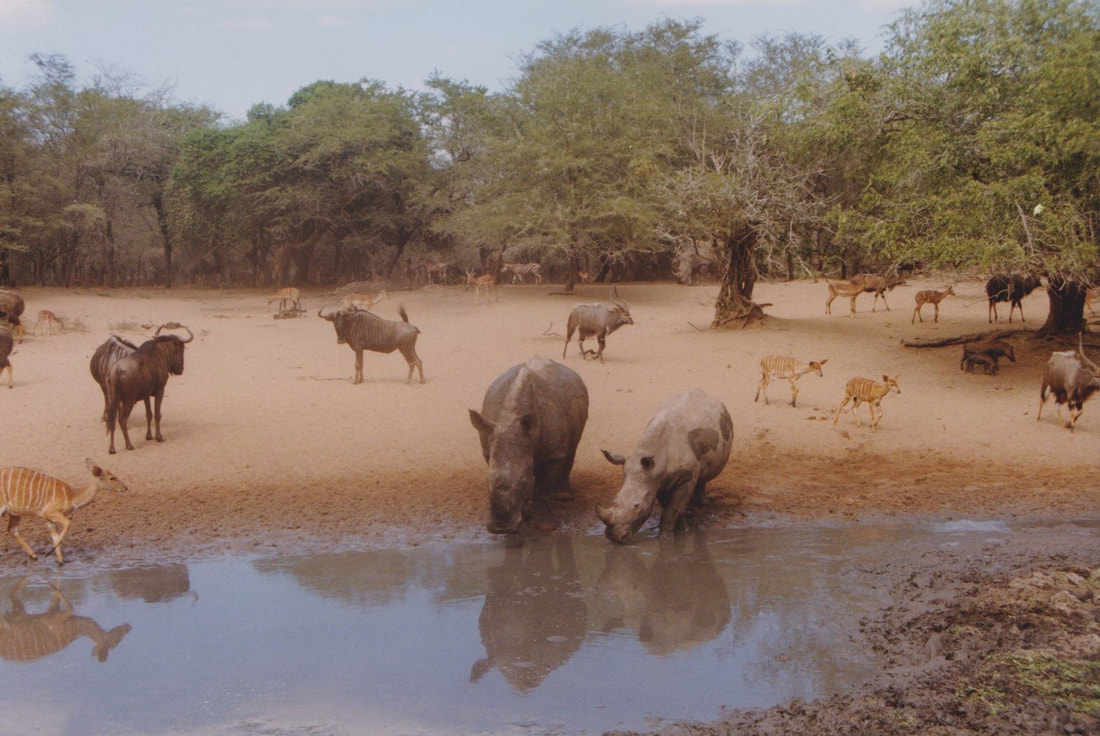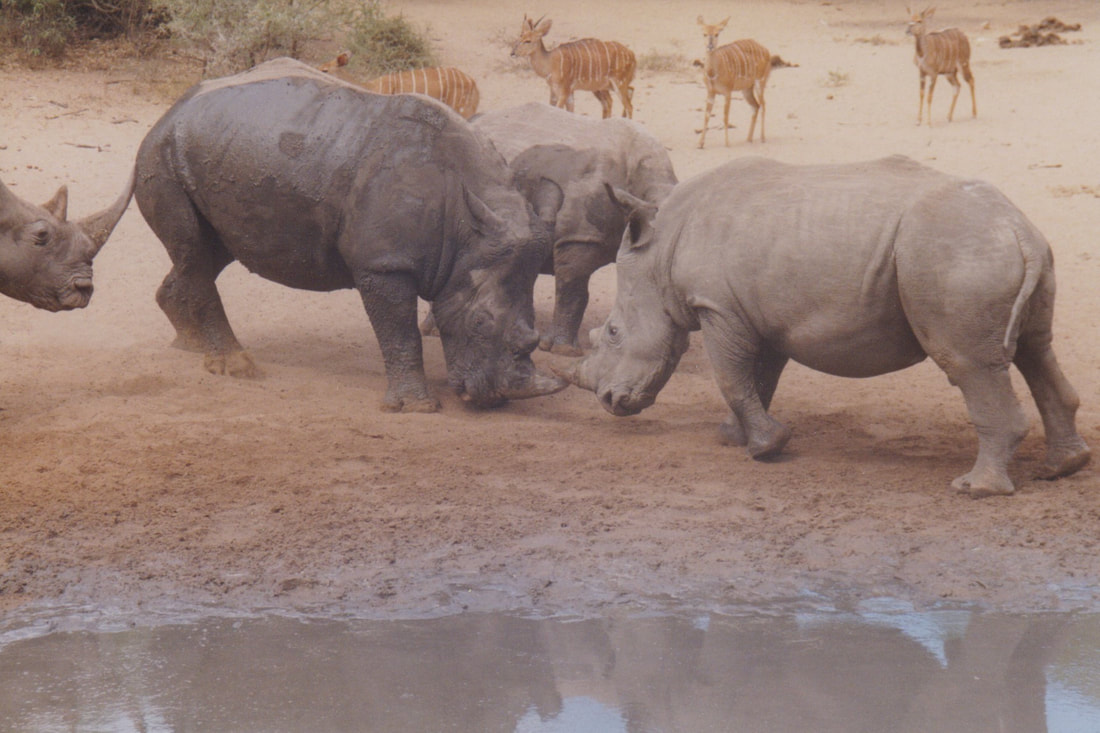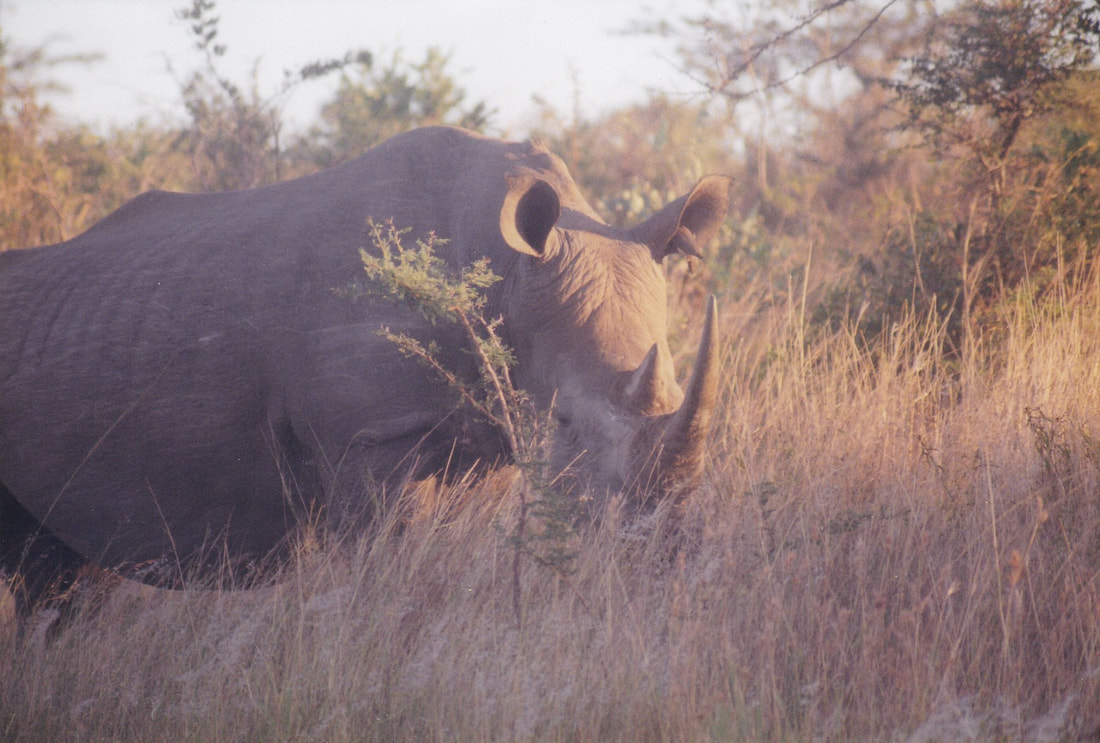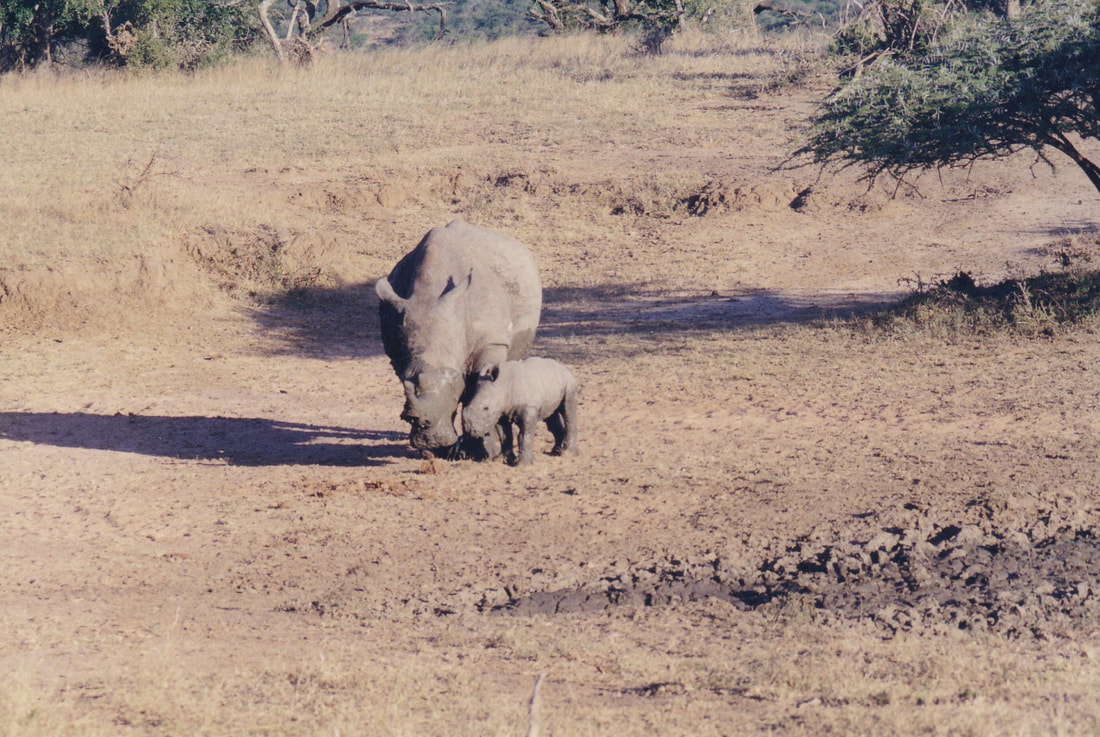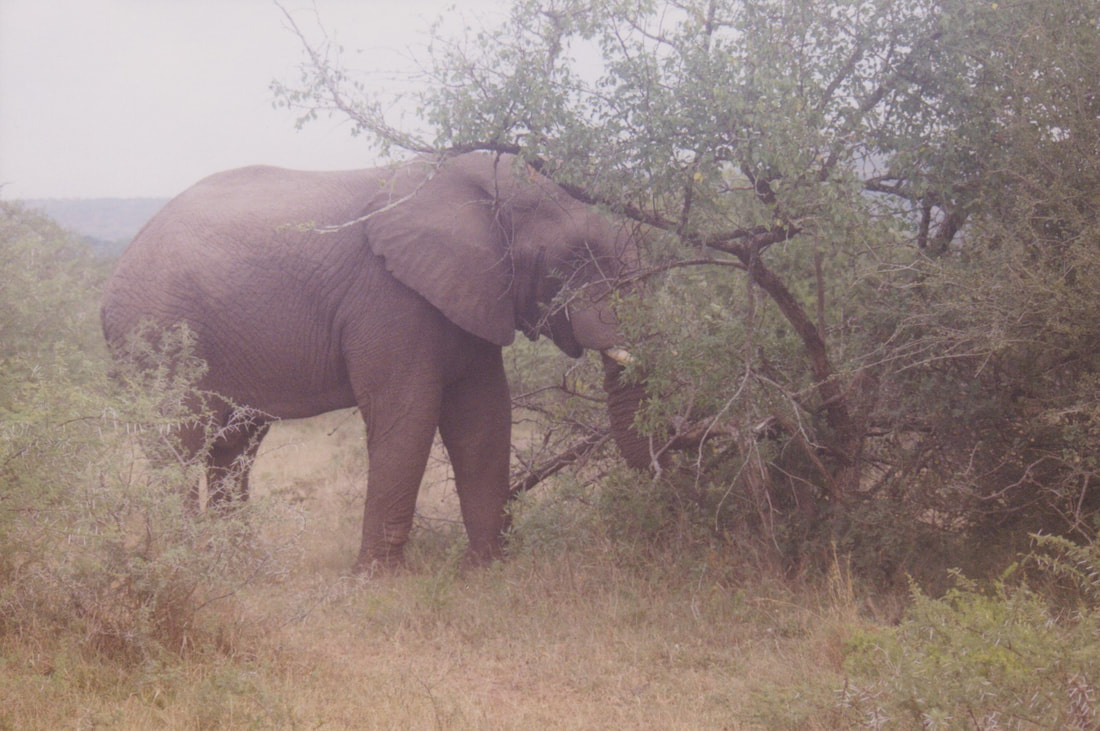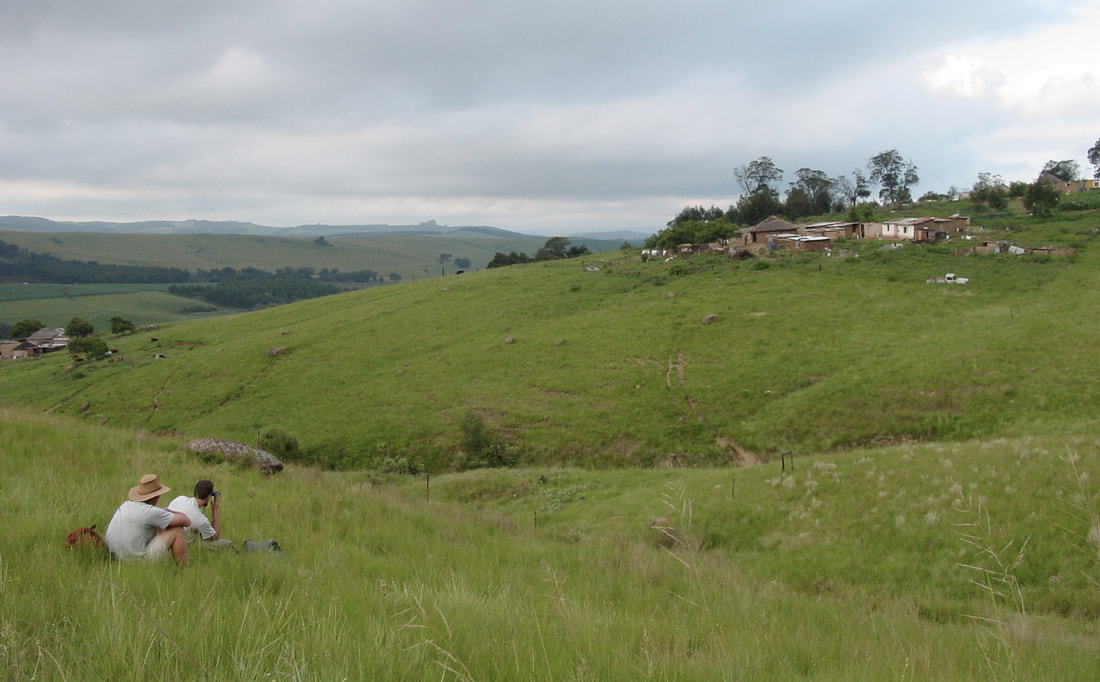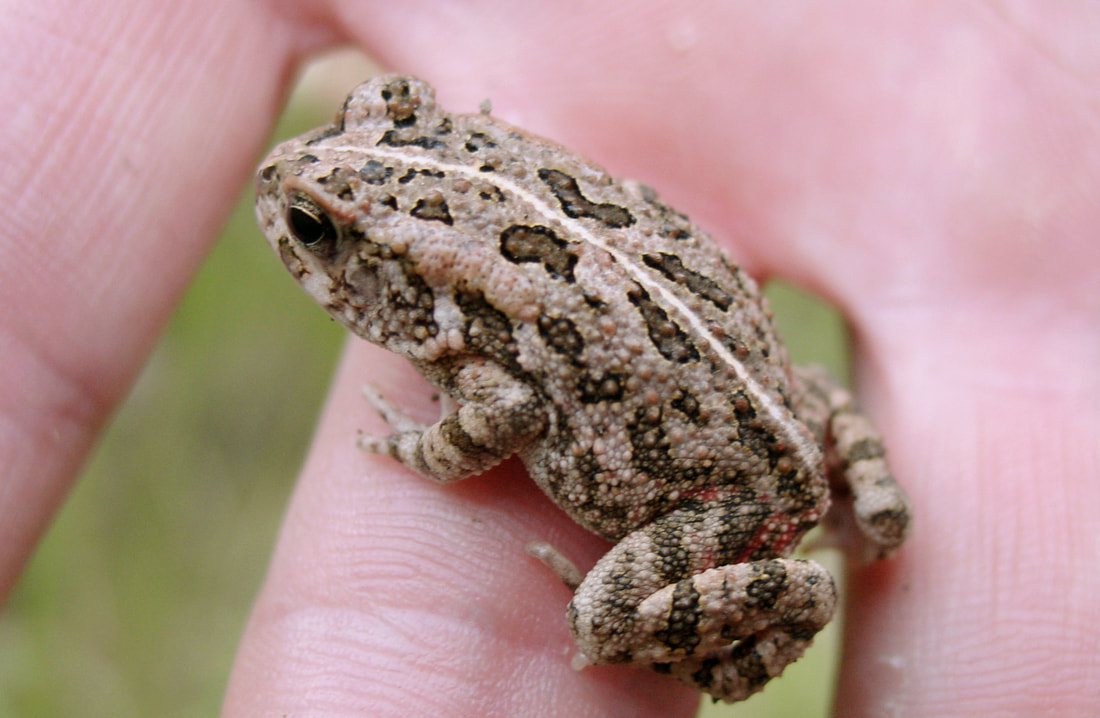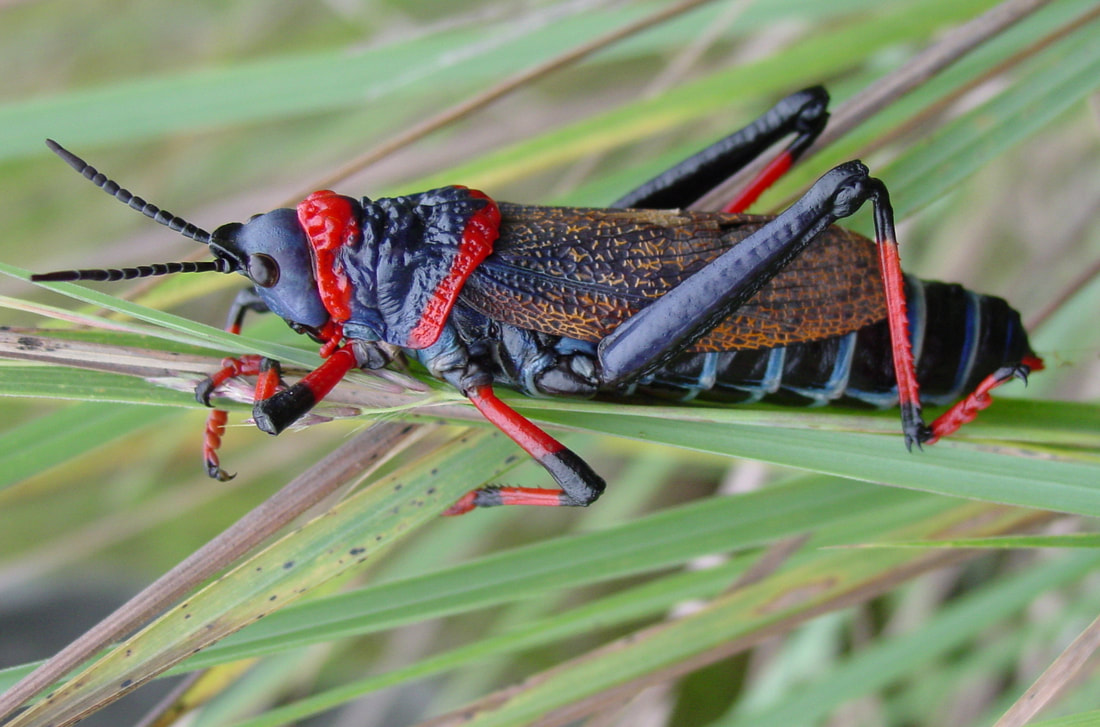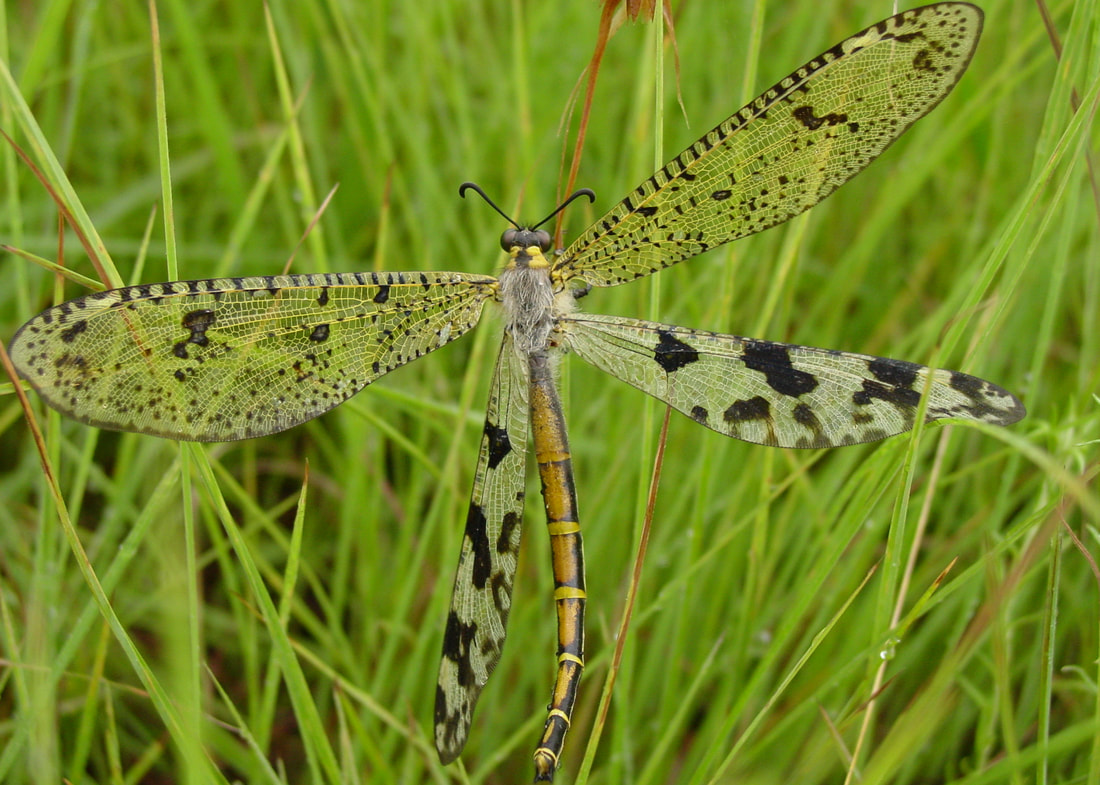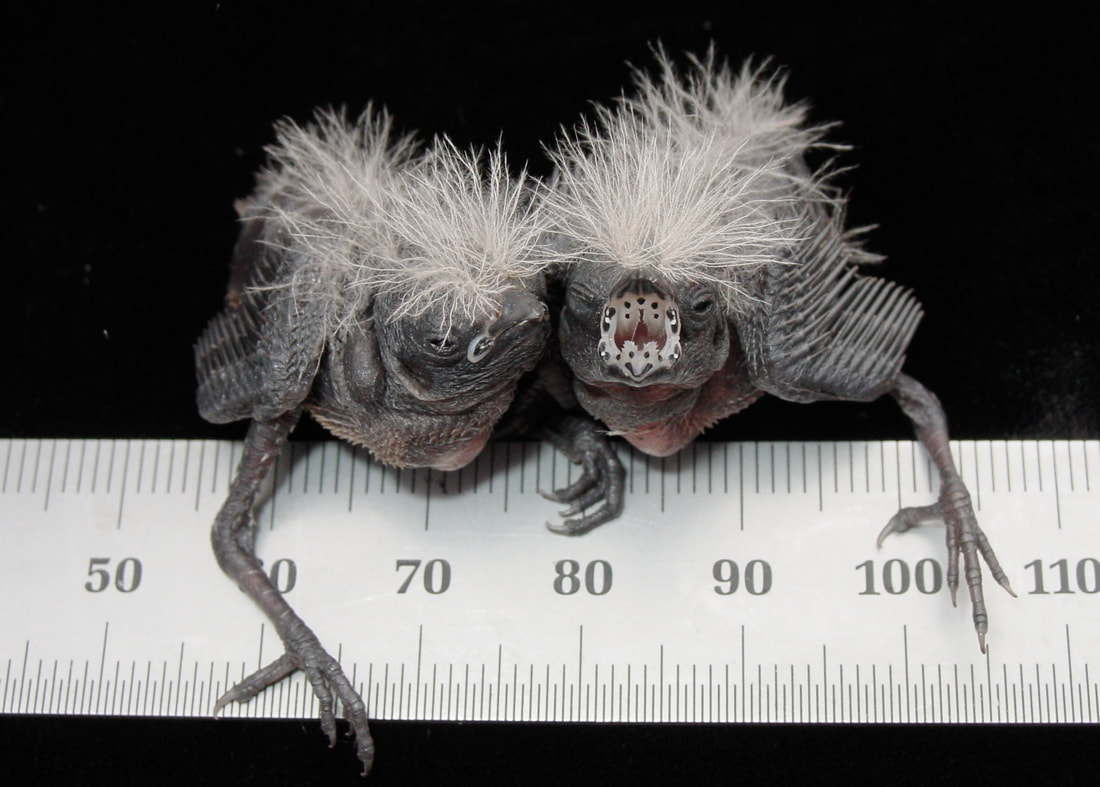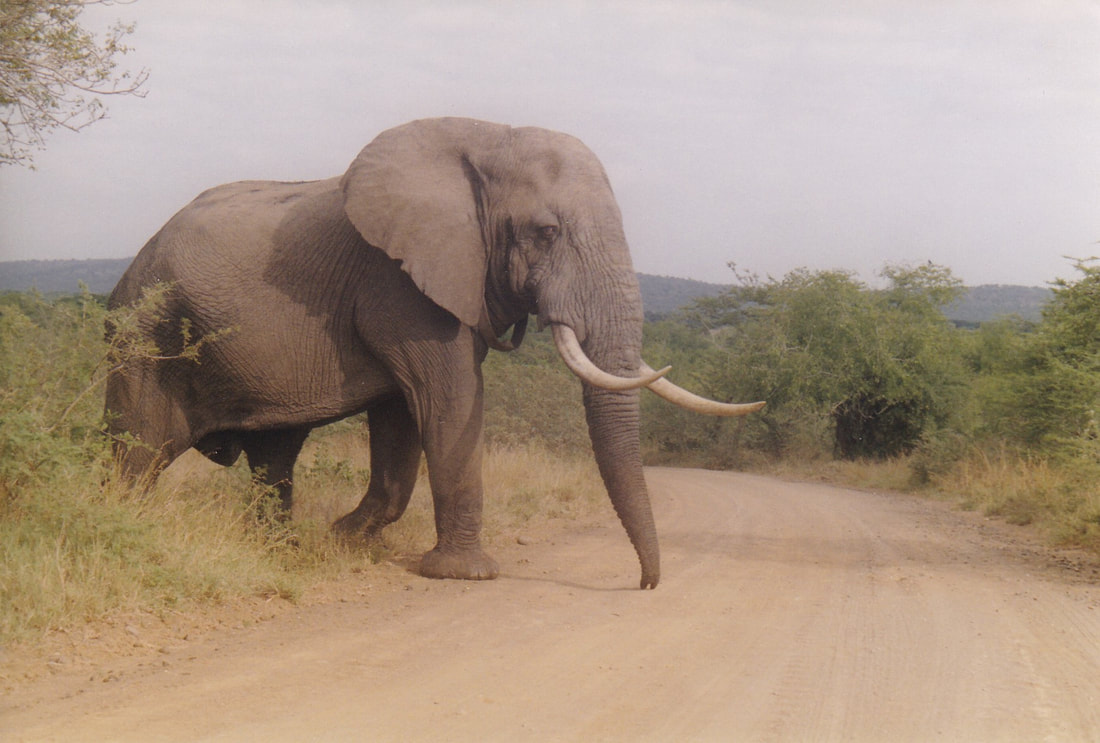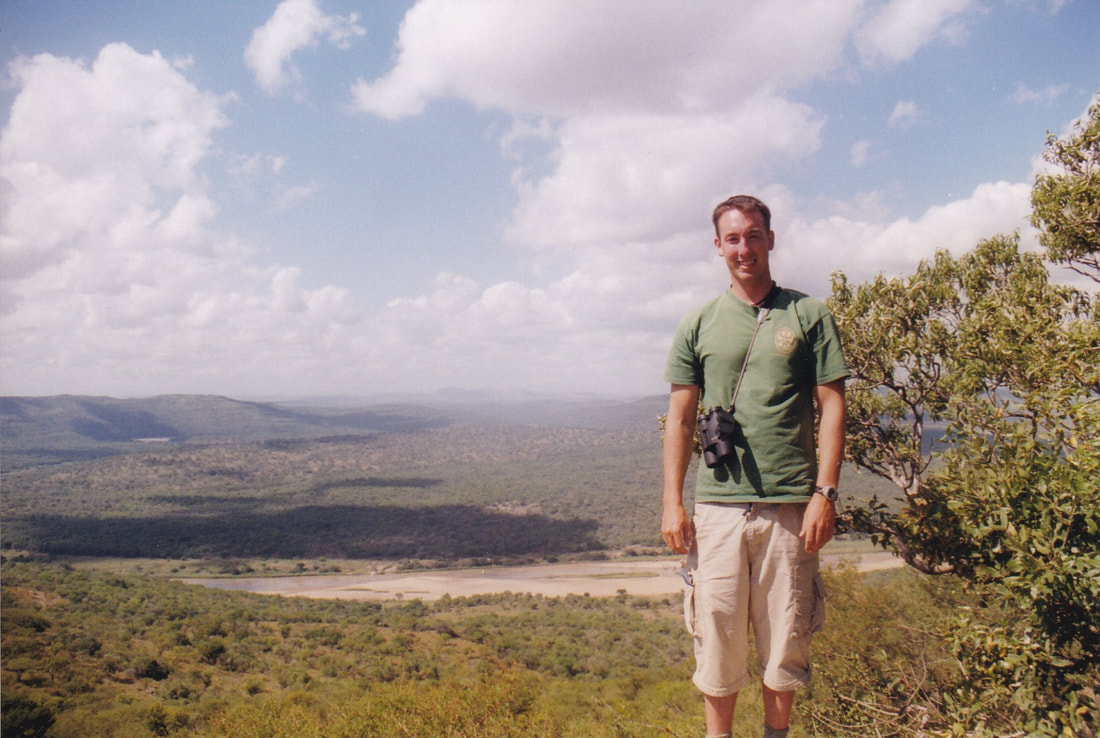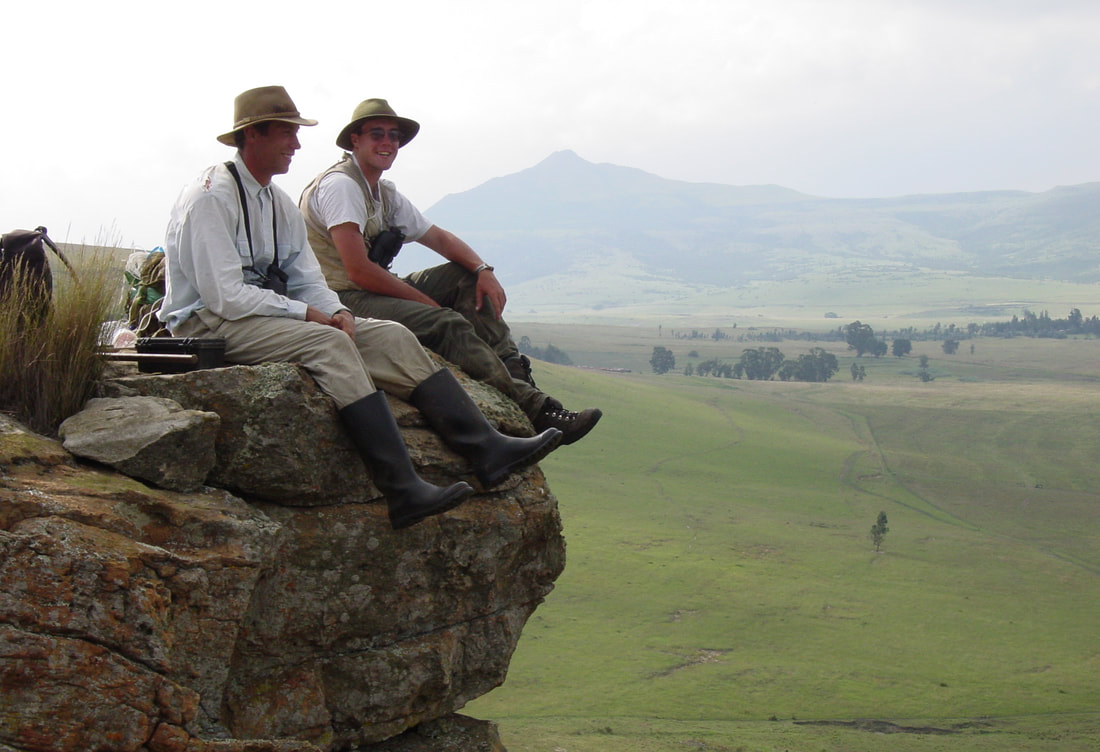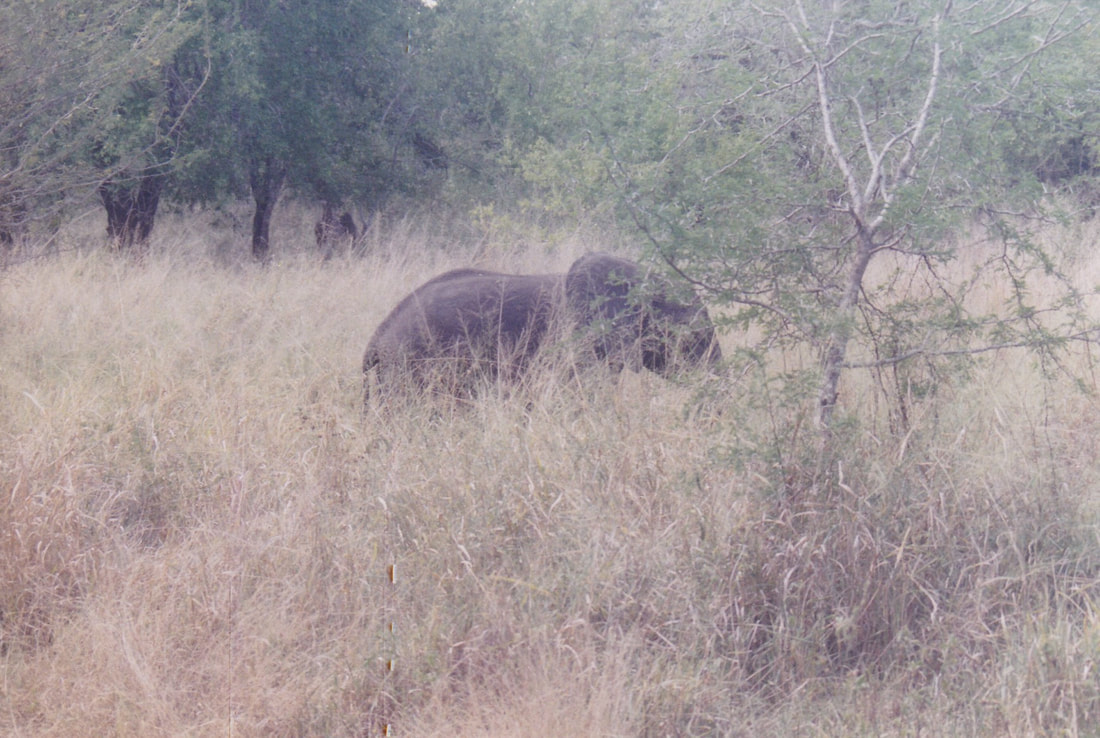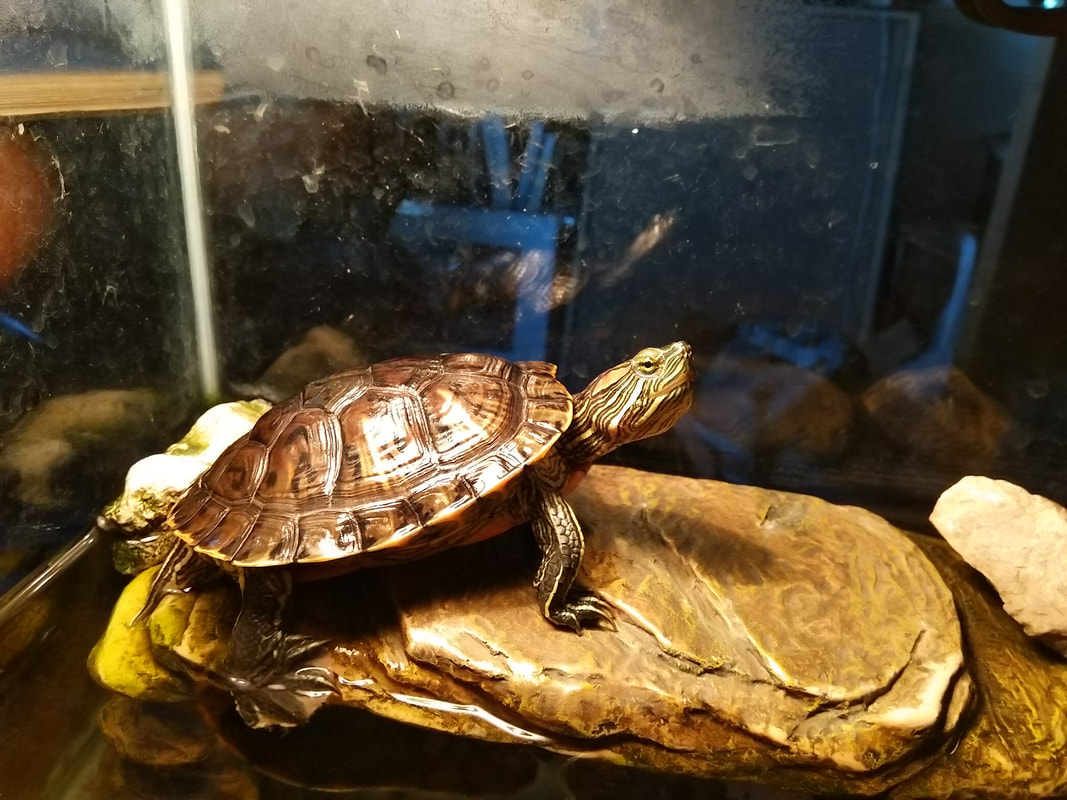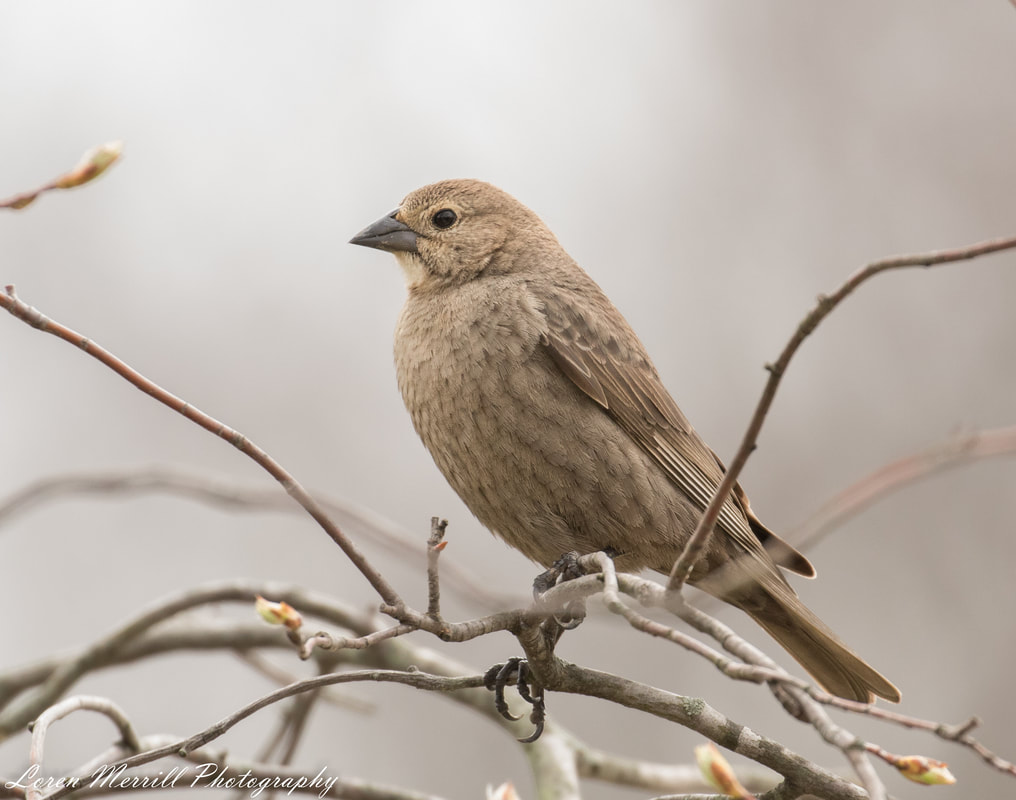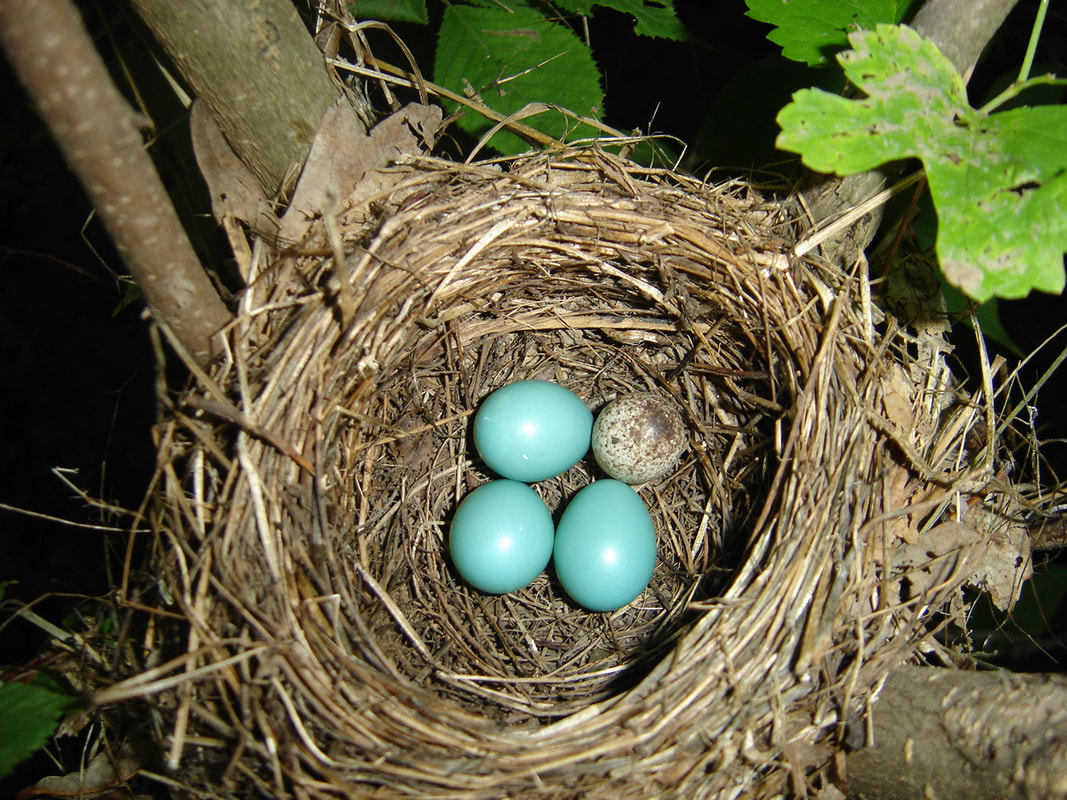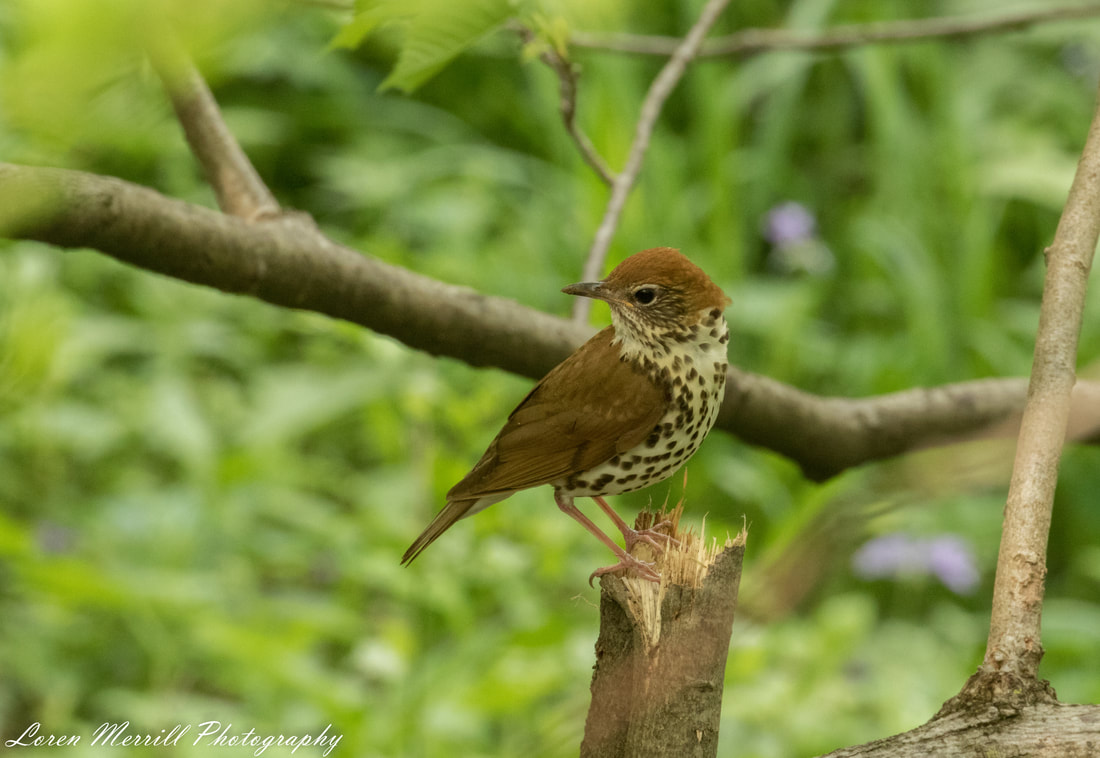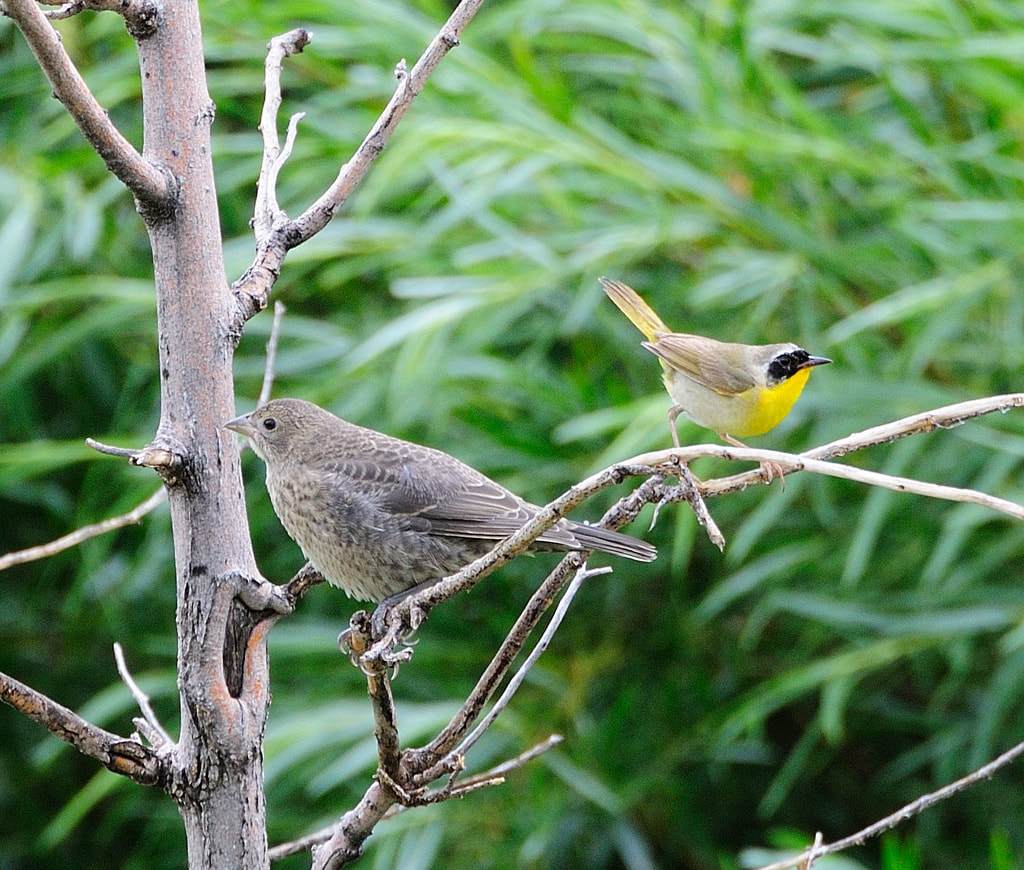|
* The next few posts will deviate a little from my normal format and represent a bit of nature travel escapism for those of us feeling a bit cooped up these days. The previous episode ended with the completion of field work in the midland region of KwaZulu-Natal, South Africa Fact: the hippopotamus is the most dangerous animal in Africa, responsible for killing more people than any other animal. (Note: this doesn’t include diseases carried by vectors like mosquitoes, or the much more dangerous Homo sapiens). This particular fact was at the forefront of my mind as I watched a pair of hippos slip under the surface of the water about 100 meters away from where I stood. Being this close to hippos wouldn’t have been cause for alarm under normal circumstances, but the circumstances at the moment were far from normal. The primary issue was that I and four companions were in a 20-foot aluminum motorboat named Vixen that was stuck in the middle of a giant, sluggish, milk-chocolate colored river teeming with hippos. Why are hippos so dangerous? It comes down to two things: a rather prickly disposition and meter-long teeth. And unfortunately for those of us stuck in the boat, one thing that really cheeses off hippos is unwanted visitors dallying in their territory, making a ruckus. At the boat’s helm, and the one responsible for our current predicament, was an overly confident South African man named Greg who now found himself at risk of incurring not only the wrath of the local hippos, but that of his girlfriend Karina as well. Ben, Justin, and I had met the couple the day before while touring around the terrestrial portion of the iSimangaliso Wetland Park (formerly known as the Greater St. Lucia Wetlands Park) in northeastern South Africa. Greg and Karina were sitting on the roof of their Land Rover looking out over a small pond, and when we stopped to watch some waterbuck foraging at the water’s edge, the couple invited us to join them on their mobile viewing platform. We climbed up the ladder and sat down, enjoying the views that the elevated station afforded us. We chatted with the two friendly South Africans, who were probably in their late 30s or early 40s, and they asked if we would like to join them on their boat the following day for a trip up the St. Lucia estuary. This sounded like an opportunity we couldn’t pass up, so we enthusiastically agreed, and arranged for a time to meet them the next morning at the boat ramp. When we arrived at the boat launch, they had just finished getting the boat in the water, and we jumped aboard, excited by the prospect of seeing some aquatic wildlife up close. Karina, who was the owner of the boat, had acquiesced to Greg’s desire to play captain, and he jumped behind the boat’s wheel. We motored away from the shore and began heading up the estuary. Despite admonitions from Karina to be careful of hidden shallow areas and to stay in deeper water on the right side of the estuary, Greg managed to captain us right into the mud in relatively short order. After a thoughtful assessment of the situation, the skipper decided that the obvious solution to the problem was to rev the motor even more and power us through the unseen mud shoals. Instead of skimming to freedom, we bogged to a whining halt with the propeller now caked in thick, sludgy mud. This was around the time that I noticed the hippos vanishing from sight and began wondering about their abilities to navigate through mud, and if they might be mollified by the sacrificial offering of our wayward captain. Another fun fact about hippos is that they don’t swim. They run, bound and gallop on the bottom, using fine buoyancy control to adjust how far from the bottom they go during their movements. Despite their tank-like proportions, they are quite graceful, and capable of reaching speeds up to 30mph in the water. Don’t believe that? Check out this video from a few years back: With my head full of useful hippo facts, various scenarios for how they would deal with us danced through my mind, and in none of them did the hippos offer to tow us out of the mud. To avoid padding the hippos’ grisly statistics, we began working on ways to extract ourselves. The boat had two small paddles that were nominally made from sturdy aluminum, but after attempting to use one to push us backwards through the mud I realized they were constructed from something akin to bendy-straw plastic. My paddle crinkled almost immediately, rendering it entirely useless. I didn’t want to appear as though I wasn’t trying to help, however, so I continued to act like I was working hard to free us with my now flexible paddle. When it became clear that we were not going to paddle ourselves to salvation, we stashed the paddles (I made sure to hide my crumpled paddle under some blankets), and we worked on developing other strategies. Justin came up with the idea of using the boat’s anchor to pull us back the way we had come. He would toss the anchor as far as he could, let it get nice and stuck in the mud, and then we would pull the boat towards the anchor. Once we reached the anchor, we would pull it up and repeat the process. It worked, and within half an hour we were able to get back to deep water. We all congratulated Justin on his brilliant idea, and our fearless captain again pointed us up the estuary, and away we went. We had no more unexpected adventures, but instead enjoyed a beautiful few hours watching hippos, crocodiles, goliath herons (the world’s largest heron), and a host of other wildlife. And I think we all very much enjoyed not being mangled to death. In classic “This is Africa” fashion, our hippo adventure was only one of many unforeseen wildlife encounters that happened on our trip. In fact, the prior day I had come face to face with an animal that I had never expected to see in the wild, nor had any idea of how to treat. As someone who had spent a good portion of his life outdoors and much of the indoor portions watching nature documentaries, I was unprepared to feel so, well, unprepared for that encounter. There are no lions in the iSimangaliso Wetland Park, so there are a few places where visitors can get out of their vehicles and walk through the bush. One of those is the Mziki Trail, and Ben, Justin and I were exploring sections of the trail that led to some animal hides overlooking waterholes. At one point I ventured off a little way from the other two, and slowly wound my way down a side trail. I spotted a Natal duiker (a German shepherd-sized antelope) bounding away through the vegetation. Not far behind was a young bushbuck (another medium-sized antelope) that was also making a hasty exit. I came to a stop. It wouldn’t have been unusual for two antelope to have run away from me, but they hadn’t exactly been running away from me. In fact, they had kind of been running towards me and then altered their course when they saw me in their path. I was trying to sort out what was going on when the answer came ambling around the corner about 50 feet down the trail. It was a honey badger. Those who are familiar with this large member of the weasel family know it is an animal not to be trifled with. Even though these wolverine-like animals only clock in at between 20 and 35 lbs, they have been known to take on lions and hyenas when defending a food source, and there are unsubstantiated reports of attacks on humans. They are also moderately indestructible. They have almost impenetrable skin, an incredibly thick skull, and an attitude that garnered them “world’s most fearless animal” in the 2002 Guinness Book of World Records. Furthermore, they have a sweet tooth for venomous animals. Well, I say sweet tooth, but I actually don’t know if venom falls on the sweet or salty side of things. Regardless, honey badgers routinely go after scorpions and venomous snakes like mambas, adders, and cobras. If an individual happens to get stung or bitten by one of these deadly meals, it might get a little sleepy and take a short nap, but then it’s up and raring to go again. So, this was the animal that was rapidly bearing down on me, making snuffling, huffing noises as it trotted along the path. Honey badgers do not have very good vision, and this individual’s attention was mostly directly towards the ground, so the prospect of having a close encounter seemed very real. Generally not one to panic, I instead froze, giving my best rendition of a tree or termite mound (my second-grade theater director would have been proud). I was at a complete loss for what to do. Climb a tree? Waive my arms and yell? I had no idea. Ultimately, I did nothing, and to my relief, when the honey badger was within 20 feet or so, it glanced up, saw me, appraised my level of tastiness, and pulled a quick U-turn. I breathed a sigh of relief, silently thankful that I didn’t smell like a big snake or some other animal from the honey badger menu. I think those people who write guides about what do to when bears attack, or when a shark is nibbling on your leg need to include a chapter on what to do when a honey badger is about to smack into you. I, for one, would find that helpful. We spent two days in the iSimangaliso Wetland Park, and then made the short trip over to the exquisite Hluhlewe-iMfolozi game reserve just off to the west. iSimangaliso had been great, but this was Africa on an entirely different level. Lion, elephant, Cape buffalo, hyena, rhinoceros, zebra, giraffe, leopard…the list of animals present in the reserve was staggering. We struck out on the cats, but we did get to see many other exciting game. The white rhinoceros was relatively abundant in the reserve, and we had a number of thrilling rhino sightings. One of our first encounters was with a massive male who wandered right up next to our car, giving us up-close views of his two-foot long front horn, and layered gray skin. There are two species of rhino: the white (or square-lipped) and the black (or hook-lipped), and white rhinos are much less ornery than their cousins. The white rhino’s broad mouths are used for grazing vegetation on the ground, while the black rhino’s pointed lips are more dexterous, allowing it to more effectively grasp leaves on bushes and shrubs. We watched the 2.5-ton male clipping grass along the edge of the dirt road for about 20 minutes, and when he had moved along a little, so did we. Towards late afternoon the next day, we came across a mother rhino and her very young calf standing at the edge of a small mud hole. Rhinos love a good wallow in the mud, and the baby had clearly been getting acquainted with this patch of mud. The mom stood watch while the baby bounded around her, testing out his new legs. Occasionally mom would herd him one way or another, using her horn to guide him in the desired direction. We were a good 100 meters away, but mom kept one eye on us and the other on the baby the whole time. After getting our fill of adorable baby rhino, we drove back to our accommodations and got our fill of pasta and beans. I’ll wrap up this post, as well as this three-part mini-series, with another elephant story. Warning: this elephant story is rated PG-13. We kicked things off a few weeks ago (Down in Africa: Part I) with an angry mother elephant threatening to crush us inside our Toyota Corolla. That experience gave us a very real appreciation for the sheer size and power African elephants possess. But in that case, it was mostly the potential for destruction that captured our attention. The day before that encounter we had witnessed the actual power that elephants are capable of when we came upon two large bull elephants foraging just off of the dirt track we were driving. We saw evidence of their presence long before we laid eyes on them; downed branches, massive dung piles, and trees knocked about like small saplings. The two bulls did not differ dramatically in size, but one, clearly the older, dominant male, had tusks that were much larger than those of the other, younger bull. The two males slowly made their way through the open savannah, grabbing branches with their trunks and shoveling the leafy vegetation into their mouths. At one point when the two elephants were perhaps 20 meters apart, there was a slightly surreal display put on by the younger bull. I have no idea what precipitated this show, but elephants do communicate in the infrasound range (below our hearing capacity) so it’s entirely possible the older bull said something disparaging to the younger one about the size of his tusks. Whatever was said, the young bull responded with the most unambiguous exhibition of machismo I have ever seen; he began thumping his own belly with his extended penis. Think male gorilla pounding his chest, only not using his hands. We were 100, maybe 150 meters away and could hear the thumping clear as day. I’m no elephant, but I certainly understood what was being said. I wondered if perhaps things would escalate and we would get to see these two behemoths grapple for dominance, but the older bull was unfazed by this youthful display of testosterone, and continued leisurely stuffing food into his mouth.
Just another day in Africa. Next post: nesting ecology of birds. Subscribe to the Newsletter! If you would like to get notifications about when new posts are up and other tidbits related to the blog, sign up for the View Out the Door twice-monthly newsletter. Just email viewoutthedoor “at” gmail “dot” com with the subject header SUBSCRIBE.
0 Comments
* The next few posts will deviate a little from my normal format and represent a bit of nature travel escapism for those of us feeling a bit cooped up these days. The previous episode ended with my arrival at the Joburg airport and collection by Justin and Ben, with whom I would be working for the next 5 months. The four-hour car ride from the Johannesburg airport to our new farm home and basecamp in the hills outside Pietermaritzburg passed in a blur of highway medians and sleep-adled haziness. When we did arrive at the gated entrance to the farm, I managed to coax my brain up from the depths of its stupor to take note of the surroundings. The landscape was a matrix of sprawling grassland, forested riparian patches, cattle pastures, and pine plantations layered upon an undulating terrain of hills and valleys. I don’t remember the dimensions now, but the farm must have encompassed hundreds if not thousands of acres. As we drove down the mile-long dirt driveway, we excitedly pointed out the new birds to one another, and gawked at the cows lazily watching us drive past. We eventually came to the primary farm compound which consisted of a main house and a smattering of smaller buildings and sheds tucked into the outlying trees. The owners—a British South African couple-- came out to greet us, accompanied by their two young daughters and four dogs: two enormous wolfhounds, and two darting terriers. As I came to learn during my time in South Africa, this sort of canine combination is quite common. The small dogs (with their acute hearing) serve as an early-warning alarm system in case of trespassers, and the big dogs serve as a deterrent with their chomping teeth and slobberous quantities of drool. After the introductions, we were shown to our living quarters, which were in a self-contained apartment unit attached to the main house. I was pleasantly surprised at the accommodations; up to that point in my field biology career I had only ever lived in a tent during field seasons, and hot water was used for cooking, not bathing. Here, however, we were in the Taj Mahal of field houses. Not only did we have beds, a kitchen, and a shower, we had access to the sparkling, sublimely chlorinated waters of the swimming pool just outside our doors. A guy could get used to this, I thought happily. The first few days were spent getting familiar with our new realm, and delineating where we would focus our work efforts. Waterbuck (a large antelope), duikur (a genus of small to medium sized antelope, ranging from 6 lbs. to 150 lbs.), lizards, an abundance of frogs and toads (many sporting white “racing stripes”), technicolor grasshoppers, giant winged antlions, and myriad new bird species were our field companions as we traversed the grassy slopes and valleys. We dodged semi-concealed holes in the ground that were the product of burrowing aardvarks, and were constantly on alert for venomous snakes like spitting cobras, black mambas and puff adders. Our target was the nest of the common waxbill, a small, mostly gray-brown finch with a fiery red mask and orange-red bill. Males are also adorned with a splash of red on their belly and chest. As I mentioned in the previous post, common waxbills are hosts to the brood-parasitic pin-tailed whydah, which is another small-bodied finch. Male whydahs, however, are boldly patterned in black and white, with long black tail streamers that are 2-3 times the bird’s body length. Males show off these streamers during mating displays in which they bounce up and down in the air in front of a female. Females are a much less ostentatious brown and tan-bodied bird, with some black streaking thrown in for camouflage in grassy environs. Once a female has selected a sufficiently attractive bouncing male and mated with him, she heads off in search of waxbill nests to deposit her eggs. I can tell you from experience that locating a waxbill nest in the grassy expanse of the South African midlands is no easy task. Waxbills build grass nests that are woven into the bases of living clumps of grass. These nests are completely enclosed, with a secret grass-tunnel entrance. As if that weren’t challenge enough, they tuck these small globular grass structures underneath a visually impenetrable barrier of overhanging grass tussocks. So what you end up with are essentially invisible grass nests scattered across a seemingly endless grass sea. For an extra psychological kick in the groin, these birds actually seem to derive pleasure in taunting nest-searchers. Unlike most small passerine birds, waxbills appear to have no qualms about venturing far outside any localized home range or territory. On countless occasions during my searches I came upon waxbills with strands of grass in their bill, only to watch them take flight and disappear over a distant ridge, giving me a parting smirk just before they vanished. But even more soul-crushing was watching a bird disappear into the distance with a beak full of cat poop. Yep, you read that right. Waxbills engage in some bizarre scatological behavior in which they weave carnivore droppings into the outer walls of their nests. They seem to prefer the scat of small to medium-sized wild cats like servals and African wild cats. These felines consume a lot of small mammals, which means that their scat is usually composed of tightly compacted strands of small mammal fur that the waxbills artfully incorporate into their nest. Servals and African wild cats are extremely secretive and rather uncommon, so their scat is a hot commodity for the waxbills. Finding a waxbill with a cat turd in its beak was a joyous occasion because it meant the bird was headed directly back to its nest. When I encountered a be-pooped waxbill (like bespectacled, but with poop in its bill), I would immediately morph into commando mode, dropping to a knee, fixing the binoculars on the bird with laser-like intensity, and preparing to sprint after the bird should the need arise. 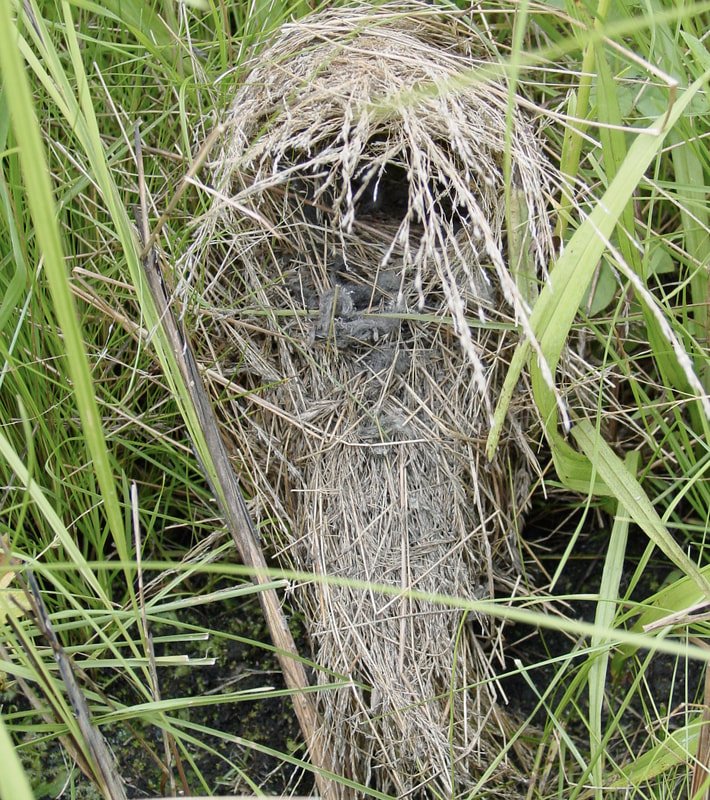 The nest of a Common Waxbill. The opening on the top is actually a false chamber, presumably meant to fool nest-predators. The actual entrance is the cascading tunnel dropping down in the front. Notice the carnivore scat at the opening to the false chamber. Also, this is a particularly conspicuous nest. Most were practically invisible. KwaZulu-Natal, South Africa. Photo credit: Justin Schuetz. It’s hard to appreciate the degree of mental anguish associated with failed nest-searching when you spend long days out in the intense African sun, plodding across boundless grassy slopes without locating a single nest. As such, the stakes feel very high when you find a bird preparing to bring home some new housing décor. However, even when everything goes according to script—the bird carries its prized possession only a hundred meters and drops down into a very identifiable patch of grassland where you can pinpoint the location at which the bird vanished from view—you can fail to find the nest. These birds are masters of visual ventriloquism (if such a thing exists); you think it went one place, and discover later that it is in fact somewhere behind you. The best you can do in these circumstances is to mark the general area that the bird vanished, retreat a hundred meters and place the entire area under surveillance. If that doesn’t succeed, you return another day hoping to perhaps flush the bird from its nest. And if that fails, you curse the birds and the nest-searching gods and move on. The curious reader will want to know why waxbills go to such lengths to defile their nests with the excrement of an animal that would happily consume them and their offspring. Cat scat, it turns out, deters nest-predation from one of the waxbill’s greatest nest-enemies; small mammals. It may come as a surprise to learn that small mammals can act as nest-predators, but many species of rodent will happily augment their normal vegetarian diet with eggs, and, on occasion, an unfortunate young nestling. (It’s kind of like the “ovo-pollo” version of vegetarianism, which, if we’re being honest, isn’t actually vegetarianism at all.) Because common waxbills nest on the ground, it is thought that they are at increased risk of nest-predation from small mammals. By adding bits of cat feces to their nest, however, they make their nest smell like a small-mammal-eating machine. To test this theory, Justin (the grad student I was working for) did some observational and experimental work examining the efficacy of having carnivore scat in the nest. He found that every natural waxbill nest that successfully fledged at least one chick contained carnivore scat, and that experimental nests with scat added were significantly less likely to get depredated (eaten) than nests without scat. A fascinating rendition of the adage “(the droppings of) the enemy of my enemy is my friend.” So, having dealt with the small mammal issue, waxbills are left to contend with the parasitic whydahs. Compared to the more virulent cuckoos and honeyguides I covered a few posts back, whydahs are relatively benign. The female whydah sneaks into a waxbill nest, lays an egg, and leaves. She may return to deposit another egg or two, but she doesn’t eat or destroy any waxbill eggs, and once the whydah chicks hatch, they don’t push the other occupants out or pierce their cervical vertebrae. On the whole, they’re rather ok for uninvited houseguests. Whydah nestlings are a bit larger than the waxbill nestlings, and according to some sources they beg more vociferously for food, which may allow them to outcompete the smaller host chicks. But in many instances, the adult waxbills are able to raise all their young, along with the parasites. Where things get interesting is when we take a look into the mouths of these nestlings. The family of birds to which the waxbill belongs (Estrildidae) is composed of over 100 species spread across Africa, Asia, and Australia, and includes some well-known members of the pet trade, such as the zebra finch and Gouldian finch. The pin-tailed whydahs are in the Viduidae family, which contains about 20 species found throughout Africa, all of which are parasites on Estrildid finches. Many of the Estrildid finch nestlings have startling bright and bizarre markings inside their mouths and lining the flanges of their beaks, and the markings of each species are generally quite distinct. Except, that is, for the markings inside the mouths of the corresponding Viduine parasite. Take our common waxbill and pin-tailed whydah duo; the whydah may parasitize other species, but the common waxbill seems to be the most frequently parasitized host, and the whydah appears to have evolved a remarkable degree of mimicry regarding the mouth markings. When we look at other host-parasite pairings, a similar pattern emerges, resulting in a dazzling example of co-evolution between the two lineages of host and parasite. But one of the intriguing, and still unanswered questions about these mouth markings is why Estrildid species that are not parasitized (such as those in Australia) also have these elaborate markings. As is usually the case, there are a few possible explanations. One is that the ancestral Estrildid finch had mouth markings, and that as species split and diverged, the markings split and diverged with them. But what purpose would the markings have served in the absence of brood parasites? Well, for one, they could act as targets for the parents inside the dark, enclosed nests that many Estrildid finches use; a “Food Goes Here” sort of beacon. The markings could also be an indicator of the chicks’ condition, allowing adults to preferentially feed the highest quality chicks when resources are limited. In his study, Justin found evidence in support of the idea that the markings are important signals to the parents. He used a non-toxic marker to manipulate the mouth markings of the waxbill nestlings to see if the parents would adjust their behavior towards the chicks with different markings. It seems that they do. While they did not eject the nestlings with the altered markings, those chicks with modified patterns experienced slight but significant reductions in growth, suggesting that the parents were providing more food to the unmanipulated chicks. This finding also provided some evidence for a selective pressure on the parasitic birds to match the markings of the host; without the right mouth pattern, the parasitic nestlings risk getting passed over by the host parents.
Over the course of the three and a half months of searching for waxbill nests, I think I found about 50 nests. It might have been closer to 70, but if we do the math, it was likely less than a nest per day on average. On most days, that didn’t matter. I was, after all, traipsing around South Africa, looking for nests, and thrilling to everyday encounters with wildlife I had only ever seen in a museum or on TV. One day, while watching some suspicious waxbill activity, a duiker came loping through the grass and nearly ran into me before noticing I wasn’t a large boulder. On another occasion I watched a blue duiker squeeze through an opening in a fence. I know that doesn’t sound noteworthy, but when I went to look at the opening the duiker had crawled through, I saw it was no bigger than my fist. Apparently, the limiting factor on the size of an opening a duiker can fit through is its skull, and the little blue duikers have awfully small skulls. I also saw dozens of new bird species, as well as exciting new reptiles and amphibians. But it wasn’t always a walk in the park. I suffered a few bouts of mild heatstroke, one case of food poisoning (never leave leftover Indian food in the car in the African summer… and then eat those leftovers later), and an annoying allergic reaction to, of all things, the sun. That’s kind of like being allergic to the wind, and it doesn’t work out well if you’re a field biologist. Essentially the problem comes down to a rapid transition from no UV exposure (like what you have in Maine in November) to high UV exposure (South Africa in their summer). And the way my body responds to this perceived insult is to burst into hives. Heat and humidity (both available in sizeable quantities in South Africa at that time of year) exacerbate the condition, as does more sun exposure. For me the issue is most pronounced on my hands, which are hard to keep covered out in the open grasslands. And once the hives are out, they do not like to be stuffed into a pair of gloves or any other covering. Unfortunately for my hives, one of the sites we worked at once or twice a week was a recently cleared section of pine plantation that was transitioning into a giant bramble thicket, and a good pair of gloves was critical for wading through the sea of thorns. This site was called Hilton, but it quickly became Hell-ton, and I dreaded our trips there. Aside from these few annoyances, the field season passed quickly, and for the most part, enjoyably. Before we headed up to Tanzania (via Egypt) for the next leg of the field project, we had a few weeks of adventure travel to enjoy. I’ve already touched on one of the elephant encounters, but in the next post we’ll visit with rhinos, hippos, and a huffing honey badger. Subscribe to the Newsletter! If you would like to get notifications about when new posts are up and other tidbits related to the blog, sign up for the View Out the Door twice-monthly newsletter. Just email viewoutthedoor “at” gmail “dot” com with the subject header SUBSCRIBE. * The next few posts will deviate a little from my normal format, and represent a bit of nature travel escapism for those of us feeling a bit cooped up these days. Elephants are intelligent, caring, and intuitive animals that also happen to be strong enough to rip a tree from the ground and knock it around like it were a stalk of grass. I think it can be hard to appreciate the full potential of power, and the capacity for destruction that an elephant is capable of until you have looked into the eyes of an angry mother elephant from inside an imminently crushable Toyota Corolla. I found myself in just such a position almost 18 year ago to the day when I was on a self-driving tour through some of South Africa’s game reserves with two compatriots. Justin, a Cornell graduate student whom I was working for as a research assistant on this trip, was behind the wheel of our parked tin can, and Ben, another research assistant on the project, was in the back. None of us spoke or moved as the massive animal bore down on us. My camera sat useless in my lap, and I gripped the door handle with my left hand, ready to spring from the car when the stomping began. Unfortunately, there were five other elephants flanking the leader, and I figured my odds of outmaneuvering all of them lay somewhere between “unlikely” and “not a snowball’s chance in hell.” So, how did it come to pass that three young men from the states had managed to so thoroughly enrage a mother elephant? The answer to this question is multi-tiered, and I will begin with the most immediate component. While touring around the excellent Hluhlewe-iMfolozi (“sh-shoo-lee im-ful-ozi”) game reserve, we had inadvertently positioned ourselves between a young elephant and its mother. To be fair, when we stopped the car and turned it off, we thought we were a safe distance from the herd of elephants that was loosely scattered among the trees on either side of the dirt road. It wasn’t until I had pulled myself out through the window, which I was using as a seat to photograph the closest elephants, that I realized there was a rather small member of the herd tucked into a shrub thicket just off to our right. I looked around for the mother, knowing that a baby this small would not be left to its own devices for long. I could see no adult in the nearby vicinity, but when I swung around to look behind me, the picture changed quickly. A group of six elephants was foraging on shrubs about 100 meters off to our left, and just as the question of whether one of these was the mother was forming in my head, the biggest of the bunch looked up. Now, some would might consider me guilty of anthropomorphizing here, but when the mother elephant saw us situated between her and the baby (in clear violation of the number one rule in nature, namely to never get between a mother elephant and her baby), I could see the following emotions cross her face; realization, then alarm, then anger. This all happened in a flash, and by the time my brain had processed what was happening, the group of six pachyderms had begun running towards us. I alerted my friends to the situation, slid back in through the open window, and began rolling the window up as fast as I could turn the crank. In my mind, I had a clear vision of what would happen if I didn’t get the window up; one of the elephants would come around to my side, reach its trunk in through the open window, pull me from the car, and mash my head into the ground to teach me some manners. Luckily, by the time the lead elephant was within 10 feet of the car I had managed to get the window about ¾ of the way up, which I figured was high enough to at least make it a sporting challenge for the elephant to extract me. With the window mostly closed, and the elephant now within spitting distance, the three of us in the car froze. Some animals are inscrutable when it comes to deciphering their emotional state; for example, my turtle Spudley may get more animated when he’s searching for food pellets, but most of the time I have a hard time discerning exactly what’s going on in his head based on his facial expressions. His state of being is generally one of the following: asleep, awake, eating, hiding. Elephants, on the other hand, leave little room for misinterpretation, especially when it comes to anger. And in this case, the lead (and largest) elephant was making her emotional state abundantly clear to us. She and the rest of her crew were now on the dirt road with us, kicking up small dust clouds as they hurried towards our car, ears flaring, and trunks going up and down (I imagined they was showing us what they would soon be doing with our limp bodies). The lead elephant (clearly the matriarch of the bunch) walked to the front of the car, which seemed to barely reach her ankles, and glared at us through the windshield. She occupied the entirety of our view, and when the entirety of your view is 5 tons of tusked fury, you could be in trouble. There is a certain euphoria, however, that comes from knowing you will become famous because of the fantastical manner of your death (“Three Americans crushed by angry mother elephant they managed to royally tick off. Baby elephant ok.”), but that passed quickly. As the three of us in the car watched, helpless as packaged sardines, the matriarch raised her front foot and swung it backwards. There was only one logical conclusion to this act; she was going to turn our car, with us inside, into an elephant soccer ball. We braced for the impending impact, but to our surprise, it never came. Instead, she swung the foot forward and stopped it inches from the bumper. She put her foot back on the ground, gave us a few more ear flares and trunk raises, then with an air of disgust, she turned to the right, and went to collect her baby. We were about to breath a sigh of relief, but that would have to wait until the other five elephants had their turn walking just in front of the car, staring us down, and giving us equally disgusted looks of contempt, with some ear flapping and trunk action thrown in for good measure. We gave them a few minutes to put some distance between us, and then Justin turned the car on, and we proceeded with our safari. After we’d all had a nice change of pants, that is. This amazing encounter represents just one of many incredible adventures from my 8-month stint in Africa. But before I jump into more adventures, now seems like a good time to address the other question regarding what we were doing in Africa in the first place. Well, we were there on a research mission: to investigate aspects of a coevolutionary relationship between an avian brood parasite (the pin-tailed whydah) and one of its hosts (the common waxbill). 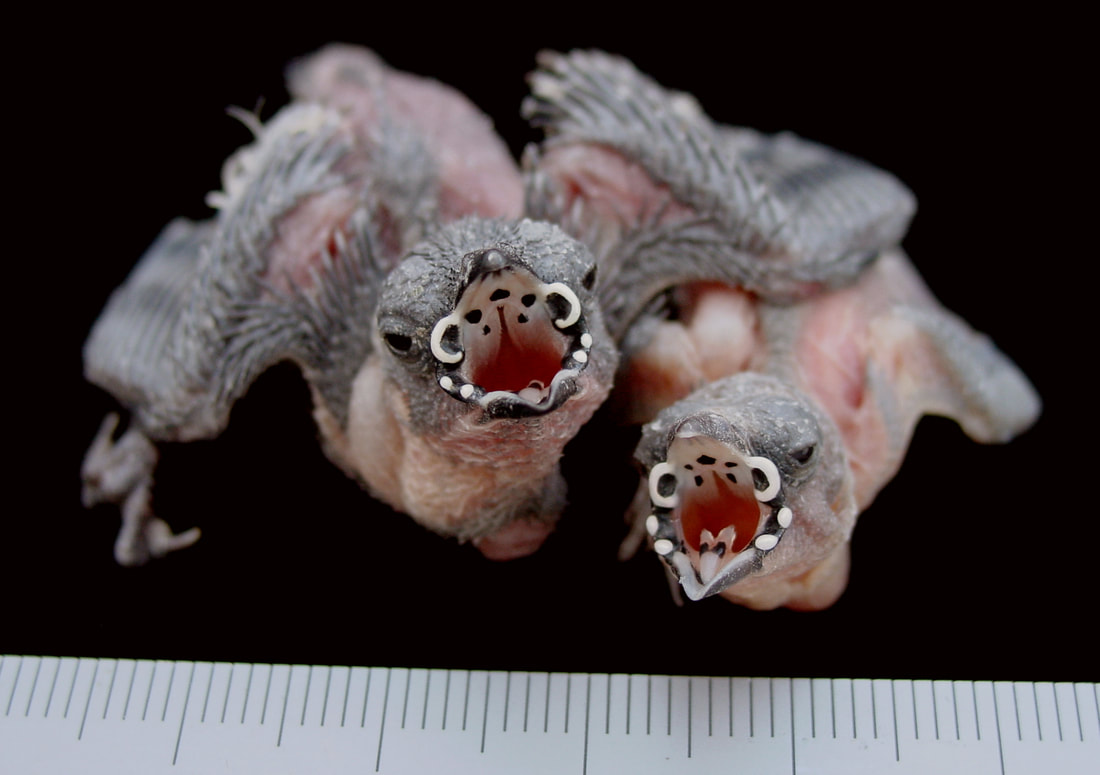 A Pin-tailed Whydah nestling on the left, and a Common Waxbill nestling on the right. These two nestlings came from the same waxbill nest, and show remarkably similar mouth markings. Is it due to mimicry on the part of the parasitic whydah? Is it convergence due to similar selective pressures of growing up inside a dark nest? We were there to find out. Image by Justin Schuetz. This was the crux of Justin’s Ph.D. research program, and he had recruited Ben and me months earlier for this intellectual adventure. Justin had been my TA for Ornithology, which I took during the fall of my senior year at Cornell. Sometime in the following spring (of 2001), he asked if I would be interested in helping him with his research, and once I found out that it would involve many months of living in Africa (both South Africa and Tanzania) I enthusiastically agreed. In late November of that year, a little over two months after 9/11 indelibly altered airline travel and what it meant to be an American journeying abroad, I boarded a plane in Boston and headed east.
My trip to South Africa took about 27 days. Actually, it only felt like 27 days. In reality it took about 2 days, and included an 11-hour layover at Heathrow Airport in London before an equally long flight down the length of the African continent. My 6.5-hour flight from Boston to Heathrow was relatively smooth, and even had a bit of luck thrown in for good measure. The woman seated to my right was clearly conjured up in a flight attendant’s nightmare, and she wasted no time in revealing this fact. She harangued the flight attendants almost constantly for the first 30 minutes, and when she wasn’t accosting them, she complained bitterly to me about whatever it was that was aggravating her. Luckily for me, one of those things was a malfunctioning headphone jack, and when she realized this, she became nearly apoplectic with frustration. She waylaid the nearest flight attendant and was summarily re-seated somewhere else that had a functioning headphone jack. Or she was tossed from the plane. In either case, it worked out beautifully for me. Once we arrived at Heathrow, I went to the luggage claim to collect my all my gear. Due to the lengthy duration of my layover, I had to grab all my checked bags and hold onto them until three hours before my next flight. That may not seem like a big deal, but in anticipation of my 8-months of field work, safaris, and travel, I had packed what one might call the opposite of light. And the prospect of being beholden to my bags for the next 8 hours didn’t sound overly enticing to me. So I gathered up my belongings, which consisted of an over-sized duffel bag (which could have comfortably held a baby blue whale), and two backpacks, and tossed the two big bags in a storage locker. Into a small backpack I stuffed my binoculars, a field guide to the birds of England, and some other odds and ends, and headed out to explore London. I spent an agreeable day exploring the city, dodging rain drops and hopping on and off the Tube (as the London underground is known). I kept my binoculars tucked away inside my backpack while I toured the National Gallery, Piccadilly Circus, and Trafalgar Square. But when I arrived at St. James Park, I came upon a large pond teeming with birds, and I finally pulled out the binoculars. At that stage in my life I was still a rather secretive bird watcher in public, so as I wandered through the park, looking at coots, moorhens, and an assortment of geese and ducks, I tried to be as discrete as one can be when peering through binoculars in a crowded city park. Luckily no-one called the Queen's Guard on me, or even seemed to notice me for that matter, and I was able to sneak around the park in peace. In the waning hours of the afternoon I made my way back to Heathrow, collected my belongings, and eventually got settled on the plane that would take me to South Africa and adventures unknown. I was due to arrive in Johannesburg in the morning, and Justin and Ben were supposed to meet me at my gate, or the luggage claim area. I remember nothing of that flight, but when I arrived, there was no Justin and Ben, so I went to the luggage claim and gathered by bags. Still no Justin and Ben. I exchanged some US dollars for South African Rand, and found a conspicuous location to sit and wait. As the minutes ticked by, my sense of unease mounted. I had no contacts in South Africa, no phone numbers, no easy way to communicate with anybody. You'll have to recall what it was like in 2001; the internet was still fairly novel, especially in places like South Africa, and getting in touch with folks was a bit more of a challenge. What would I do if they never showed? Wander the streets of Johannesburg, living inside my giant duffel bag? Fortunately, I never had to experience life as a human hermit crab, as Justin and Ben eventually appeared (they had been stuck in traffic), and helped me schlep my stuff to the little Toyota Corolla parked outside. We pulled out of the airport and headed southeast towards Pietermaritzburg and our new home in the pastoral valleys of the eastern midlands. Next Post-- Down in Africa: Part II. Imagine for a moment that you’re a female wood thrush, and you’ve been busy over the past week building a cozy nest-home that is now populated with four lovely eggs. You look down into the nest to admire your handiwork when you realize something is off; one of the eggs in the nest doesn’t look like the others. Three eggs are blue and unmarked, whereas the “other egg” is a little smaller, less blue, and has some speckling. “That’s odd,” you muse to yourself as you study this aberrant egg. “Did I eat something bad last week?” You think back over the week’s menu of squishy invertebrates and desiccated fruits. “Maybe it was that caterpillar with the spiky hairs, or those old mystery berries,” you speculate. Regardless, you have a decision to make: will you keep this mismatched egg, or toss it from your nest? You consider the options. On the one hand, it’s an egg in your nest, so it seems as though the most likely scenario is that if came from you. On the other hand, you’ve heard rumors of an egg-dumper in the neighborhood--an unknown bandit going around, depositing eggs in the nests of others. Could this be an imposter egg that was swapped in for one of your own? If that’s the case you could be wasting valuable resources by continuing to incubate the egg, and worse still, feed it once it hatches. But what if it really is just a weird looking runt egg you made because you ran out of blue pigment and hadn’t eaten much the day before? If you toss it, you’re throwing out your own offspring, and given that the odds of you surviving to the next breeding season are pretty slim, the loss of one offspring is a big deal. So you decide to keep the egg. You settle down on the nest, and for much of the next 11 days, you devote yourself to keeping the eggs warm and safe. On the 11th day, the misfit egg cracks open, revealing a small, blind, and featherless chick. As you gather up the broken bits of eggshell for disposal away from the nest, you inspect the exhausted chick. Aside from the fact that it hatched earlier than the other eggs and looks a little small, this naked hatchling appears normal. Within a few hours it has recouped its strength and starts begging for food. Your partner begins bringing small, soft-bodied invertebrates to the nest, and stuffs them into the chick’s oversized mouth-funnel. The next day, the other eggs hatch, and soon you’ve got four mouths to feed. Over the first few days post-hatch your partner does most of the provisioning as you continue to brood the young chicks, keeping them warm and safe from predators. But soon the four chicks (which are really just stomachs with mouths) require more food than your partner alone can provide, so you begin helping gather food. As you go back and forth from nest to forest collecting caterpillars, spiders and the like, it seems as though Chick 1 (your descriptive name for the first-hatched chick) is always begging, begs louder, and may be getting more food than the others. This concerns you for a little while, but you are quickly overwhelmed with work, and all thoughts of nestling inequity vanish behind the all-consuming job of providing food for the four noisy bobbleheads in your nest. The next week vanishes in a blur of high intensity parenting, and before you know it, you’ve got four teenaged fledglings looking tough with their punk feather-dos, crowding the nest and pooping everywhere. And one of those indiscriminate poopers has a funny look about him. Rather than the rufous undertones and defined spotting that the other chicks are sporting, he’s got a dull gray coat, and some messy streaking on his chest. “I should really watch what I eat next time I’m laying eggs,” you think to yourself. And then, one day, when all your other teens are testing out their wings, flying into tree-trunks and the mouths of waiting predators, Chick 1 vanishes. You call for him, and fly around desperately looking for him, but there’s no sign anywhere. You return to your other offspring and spend the next few weeks getting them ready for life on their own. The next time you see Chick 1 is a month later and he’s hanging out at the edge of a large field with a gang of cowbirds and grackles. You call to him, but he pretends not to hear you, and that’s when you realize what’s happened; your son isn’t just hanging out with a bunch of cowbirds. He IS a cowbird. Your fears are confirmed: you spent a month raising a brood parasite. Brood parasites come in a couple of flavors, and like ice-cream, none of them are good for you (if you’re a host). There are obligate brood parasites which only lay their eggs in the nests of other species. There are facultative brood parasites, which are species that will opportunistically lay their eggs in the nests of other species when the situation presents itself (many ducks will happily drop an egg or five in the nest of another duck species if the opportunity arises). And there are intraspecific brood parasites, which are individuals of a species that will deposit an egg here or there into the nest of another member of the same species. Obligate brood parasitism is thought to have evolved seven different times in birds; in the New World blackbirds (cowbirds), the Old World viduine finches (indigobirds and whydahs), the African and Asian honeyguides, one species of duck (the black-headed duck), once in the Old World cuckoos, and twice in the New World cuckoos. None of the obligate brood parasites build their own nests or raise their own offspring; every egg that a female lays she deposits in the nest of another species. Aside from that one shared trait, obligate brood parasites exhibit a fascinating array of strategies for duping the foster parents and rigging the odds in favor of the parasitic chick. Regarding the latter, some brood parasites have evolved rather ruthless tactics for ensuring that they get plenty of attention from the host parents. Old World cuckoos get to work on this almost as soon as they hatch. Blind, naked, and barely coordinated enough to keep from toppling over, the cuckoo chick endeavors to eliminate all competition from the nest as fast as possible. They do this by scooting backwards around the cup of the nest, and when they encounter something like an egg or another chick, they begin pushing it up the side of the nest. The single-minded parasite chick accomplishes this task by balancing the egg or chick on its back until it reaches the rim of the nest, and then, with a final heave, the egg or chick is pushed over the edge. The cuckoo repeats this action until it is the sole occupant of the nest, thereby ensuring that it will receive all the food that the host parents bring to the nest. But the trophy for most grisly tactic goes to the honeyguides. Adult honeyguides are named after the behavior displayed by one or two African species which have developed a symbiotic relationship with humans, possibly dating back as long as 2 million years. These birds have a particular fondness for bee larvae and wax, but don’t have the means of breaking into natural beehives. Luckily for them, people have a particular fondness for honey, and the means of breaking into the hive to get it. So the honeyguides lead people to bee colonies where the humans use tools to open the hive and scoop out the honey. Once the two-legged honeyeaters are done, the honeyguides move in to collect the bee larvae and the wax (honeyguides are one of the few animals that can digest wax). The cooperative nature of the adults belies the sinister behavior their chicks exhibit upon hatching. Honeyguide chicks emerge from the egg with some lethal hardware; a sharply pointed and curved-tipped bill, which they use to quickly dispatch their nest-mates. The host parents eventually remove the dead chicks, and the little parasite nestling is all that remains. With no competition for food, the honeyguide chick grows rapidly, and is soon out in the world, looking for its own humans to break open beehives. Not all obligate brood parasites are as virulent as the Old World cuckoos and honeyguides, however. In North America, the brown headed cowbird is by far the most wide-spread and common obligate brood parasite, and the impact of the parasite on the host is much more variable. A cowbird chick in a nest of red-winged blackbirds is thought to have relatively little negative impact on the parents or host chicks, other than the loss of the one egg that the female cowbird removed and replaced with her own egg. In contrast, a cowbird chick in the nest of an eastern phoebe, or a common yellowthroat has a much bigger impact. The larger parasitic chick typically outcompetes all the host nestlings, which often succumb to starvation. There are few questions that regularly arise at this point in the story—“Why do brood parasites exist at all?” “Why don’t the hosts stop the brood parasites?” and “Why don’t all birds do this?” There are many answers to these questions, and numerous researchers have spent their careers pursuing these questions, or variants of them. The first question is relatively easy to address; if you could get someone else to invest considerable resources into the growth and development of your offspring at little to no cost to you, you would jump at that opportunity! Or some of us with more parasitic tendencies would anyways. To think in these terms, you have to ignore the emotional and hormonal mechanisms humans have evolved as a way to ensure that adults provide their children with the nurturing and care they need to develop properly. As a fun thought exercise, consider a world in which another species of hominid co-occurs with us (we’ll call them Homo parasiticus), and this species provides no parental care at all. Instead, they sneak into hospitals at night and deposit their offspring into the cribs with Homo sapiens newborn infants. Their babies look so much like ours, we can’t tell them apart, and are obligated to raise both babies (genetic testing would be the end of this parasitic species, alas, at least in developed nations). The H. parasiticus adults are free to invest all their time in work, leisure, research, arts, the development of nuclear fusion, space-travel, crossword puzzles, etc. Moreover, without the economic constraints of child-rearing, they are free to reproduce at much greater rates. This strategy is a great success! And this leads us to the next question: Why don’t hosts stop the brood parasites? The short answer is that many hosts do, or try to anyways. In many cases, there is an evolutionary tug-of-war, or arms race, at play. Many of the cuckoo hosts in the Old World have learned to recognize their own eggs, and any parasite egg that looks different is rejected. This in turn has led to egg mimicry on the part of the cuckoo; that is, they now produce eggs that look like the eggs of their hosts. You can see where this is going. In North America, the brown-headed cowbird has experienced largescale range expansion over the past 200 years as humans (and their cows, which cowbirds are often associated with) have spread out and modified the habitat across the continent, often to the cowbird’s liking. This means that there is now a spectrum of host-parasite relationships in place. In areas where cowbirds historically occurred, many of the hosts have strategies to deal with the parasites. Yellow warblers, for example, will abandon their nest or build a new nest on top of their old nest if a cowbird has parasitized it. American robins are experts are recognizing foreign eggs, and almost always remove them from their nests within a day or two. But species that historically didn’t experience high rates of cowbird parasitism often have no defenses and accept cowbird eggs without prejudice. One prominent theory suggests that the lack of parasite defenses in these hosts is a product of “evolutionary lag” and that, in time, hosts will evolve strategies for coping with the parasites.
But there are other reasons why hosts may accept the brood parasite’s eggs. One possible (and slightly controversial) reason is that brood parasites employ some Mafioso-type tactics to ensure that the hosts accept their eggs. There are no severed horse-heads or concrete-boots involved, but the idea is that the female brood parasite will return to a host nest where she has deposited one of her eggs, and if the host has removed that egg, the female parasite will destroy the nest. This serves two purposes; one, it forces the host to re-nest, thereby providing the parasite with another opportunity to parasitize the nest, and two, it acts as a warning to the hosts: “Remove my egg, and I will destroy your entire home and all your babies!” You can see how this would be a convincing argument, especially with no birdie law-enforcement around to help. Other explanations for why hosts may accept parasite eggs have to do with learning (it’s possible that host females have to learn what their own eggs look like before they can identify a foreign egg, and if a parasite egg is in their first nest, they may not learn to recognize it as a parasite), costs of mistakes (rejecting your own egg by mistake, or accidentally damaging your eggs in the process of trying to remove the parasite egg can be quite costly), and evolutionary constraints (e.g. egg recognition isn’t part of the species’ evolutionary repertoire, they are too small to remove the parasite egg, or they have a bizarrely-shaped bill that won’t allow them to move it, etc.). The final question regarding “why doesn’t everyone do it if it’s so great?” is multifaceted. First, and most obviously, if every species were a brood parasite, there would be no host species to raise them. Slightly more nuanced than that is the idea that hosts and parasites are governed by frequency-dependent processes; the more parasites there are, the stronger the selection on the hosts to counter the parasites. Another possibility is that maybe it’s not so great to be a brood parasite after all. At least, not a female brood parasite. Female cowbirds, for example, live less than two years on average, and some of my PhD work indicated that female cowbirds have significantly reduced levels of immune function compared to male cowbirds and both males and females of the closely related, but non-parasitic, red-winged blackbird. The idea behind this is that female cowbirds invest huge amounts of resources into egg production (laying as many as 20-40 eggs in a season) and that this comes at the expense of their health and ultimately survival. Brood parasites often get a lot of bad press, but the reality is that they are simply doing what evolution has molded them into doing. And when you stop to think about all the adaptations they have for this unique lifestyle, you can’t help but be amazed by them. Subscribe to the Newsletter! If you would like to get notifications about when new posts are up and other tidbits related to the blog, sign up for the View Out the Door twice-monthly newsletter. Just email viewoutthedoor “at” gmail “dot” com with the subject header SUBSCRIBE. |
About the author:Loren grew up in the wilds of Boston, Massachusetts, and honed his natural history skills in the urban backyard. He attended Cornell University for his undergraduate degree in Natural Resources, and received his PhD in Ecology from the University of California, Santa Barbara. He has traveled extensively, and in the past few years has developed an affliction for wildlife photography. Archives:
|
